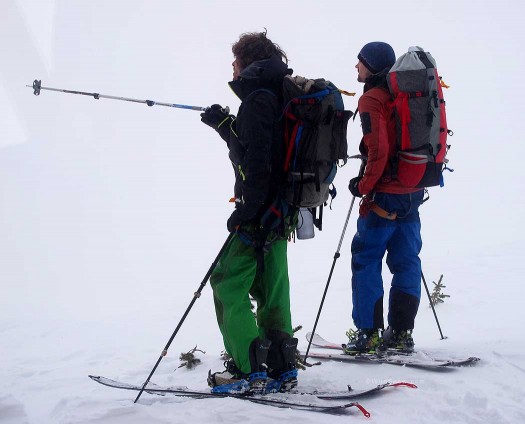Avalanches are the greatest danger that skiers, snowboarders, climbers, and snowmobilers face on trips into the backcountry. There are many resources available for avalanche safety, including classes, avalanche forecasts, and websites. However, every year many people get caught and are killed by avalanches. In hindsight, many of these incidents were seen to be largely preventable, so why did they happen? How can similar incidents be prevented?
Many recent avalanche incidents have been shown to be due to heuristic traps, to some degree. Heuristics are decision-making shortcuts, often called “rules of thumb”, that most people use every day for a variety of decisions. For example, using “common sense” is a heuristic used by almost everyone. Hueristics work great in many every day situations, particularly routine ones. A heuristic trap is formed when a heuristic is used in a situation where it results in a wrong decision. Many people use heuristics for evaluating avalanche danger, not knowing that they are an ineffective tool for doing so. Heuristic traps are difficult to prevent, but knowing what traps to look out for can help immensely. In this article I aim to briefly explain some common heuristic traps seen by backcountry skiers. There are a variety of traps, however six are seen frequently in avalanche safety; familiarity, consistency, acceptance, the expert halo, social facilitation, and scarcity.
Familiarity
This heuristic trap relies on our past actions to make decisions in familiar settings. This works great in many every day situations, such as crossing the street, however it doesn’t work well when there are unseen dangers. Avalanche danger changes rapidly, often without obvious indicators. Skiers in familiar terrain tend to take much more risks than when they are skiing in a new area. Unfortunately knowing an area helps very little when evaluating avalanche danger. The heuristic is difficult to avoid, and requires careful self-examination. When skiing in familiar terrain, keep in mind the current avalanche danger rating. Ask yourself: “would I be skiing this slope if I had never been here before, with this avalanche rating?”. Someone saying “it’s alright, I’ve been here a bunch before” should be a major red flag.
Consistency
Once a major decision has been made, it is much easier to make subsequent decisions line up with the conclusions of the original decision. This is called the consistency heuristic. Often initial decisions about avalanche danger are made early in the day, before much information has been gathered. This can be very dangerous. Throughout a day of skiing, observations may be made that significantly change your perception of the avalanche hazard, and require re-evaluation. Unfortunately this is made difficult by the consistency heuristic. A reasonably effective method of minimizing this heuristic is to stop periodically throughout the day and make a conscious effort to re-evaluate the hazard, starting from scratch.
Acceptance
This heuristic is common in many situations throughout life. Humans naturally desire to be accepted by others, and we alter our behavior to achieve this. This is particularly a problem in action sports such as skiing and snowmobiling, where decisions are often based on what will impress others. This can cloud decision-making significantly. An effective way to counter this trap is in the careful selection of backcountry ski partners, particularly on high avalanche danger ski days. Partners and friends who already accept you are good choices.
The expert halo
Backcountry ski groups often have an informal “leader”, often the most experienced member of the group. Often this individual tends to make decisions for the entire group, making them miss critical danger signs that other group members noticed. This is more pronounced in groups that have a large disparity between the avalanche knowledge of the members, and is related to the acceptance heuristic. Opinions and observations from all group members should be valued equally, no matter the skill level. Effort should be made to have group discussions, to avoid one person making critical decisions alone. Also, less experienced members need to realize it is important to speak up and voice their opinions.
Social Facilitation
This heuristic has the effect of exaggerating an individuals risk taking tendencies, when in a social setting. A high risk taking person will take more risks around others, conversely, a low risk taking person will take fewer risks when around others. In contrast to the two previous heuristics, this takes place when skiers encounter others outside of their original group. This can be mitigated in several ways. First, as with all heuristics, be conscious of how this may affect your decision making when in applicable situations. Also, trips can be planed beforehand to areas where there may be fewer people. Not only can this increase safety, but it often results in a more enjoyable experience.
Scarcity
This heuristic is also known as “powder fever”. When people are competing for limited resources, they are much more willing to take increased risks. This particularly applies for skiers who are hoping to get fresh snow, before other ski groups are able to. This is yet another reason to carefully plan ski trips to avoid areas that have a large amount of other skiers.
Heuristic traps are prevalent in all areas of life, and can be mitigated to help in a variety of situations. It is easy to forget or become lazy about preventing these traps, and they can re-emerge. It is important to talk about these heuristics with your ski partners, it can save your life!
Louie Dawson earned his Bachelor Degree in Industrial Design from Western Washington University in 2014. When he’s not skiing Mount Baker or somewhere equally as snowy, he’s thinking about new products to make ski mountaineering more fun and safe.

